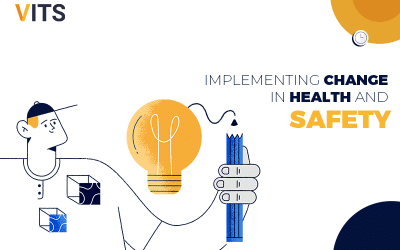Change....
It’s easy to talk about. It’s simple to plan for. But implementing that change? That’s the tricky part. A great leader knows when to implement change, while an outstanding leader needs the management skills to know how to implement change.
Why Does Change Management Usually End Up in a Disaster?
Workplace initiatives and change are often met with friction when implementation is not inclusive of the whole team.
While executives will be the decision-makers on when and how to execute change management in health and safety, the entirety of the team needs to be involved for this change to be effective and have a lasting positive impact.
There are few types of change more important than health and safety initiatives. Despite this paramount importance, many companies experience resistance from their teams when it comes to the actual implementation of that change.
In order for your health and safety initiative to be embraced wholeheartedly by your team, it needs to be delivered in an appropriate way.
Leaders are not lone wolves. And it cannot be from this standpoint that they attempt to offer transformation in a workplace, as support needs to come from the entirety of the team.
This is not as difficult as it initially seems. Because it’s all in the delivery.
Delivering Change: The Efficient Way

Change can be uncomfortable whether you are managing a small team or a large one. However, there are ways to shift the narrative towards embracing change, rather than resistance.
Here’s how to do just that.
A. Use Relevance to Replace Resistance
This doesn’t mean inviting them into the boardroom at the bureaucratic level of signing in change. But what it does mean is offer them relevance. Not only should you offer the relevance behind the change, but allow the team and staff to feel relevant members themselves.
Leaders have the highest chance of success when they allow their teams to feel as if it is co-created. Disregarding the command and control style can go a long way towards gaining control and experiencing ease in a changing landscape.
If an executive engages with their employees, whether its middle management or ground level workforce, they can almost expect commitment from the team.
B. Focus on the Delivery
Ignite the ‘why’ within your team. This gets your team to understand the importance of the change
With effective communication, a leader can offer the workforce the “why” behind the change. This way, staff form an innate understanding of the relevance and meaning behind the change.
If they are offered the potential problems that could be caused without the change, then offered the change as the white horse solution, then they can form their own narratives of how this change could help them in their day-to-day workplace.
It becomes personal, effectively reducing resistance as it does so.
C. Offer the Value
What’s the number one reason for people, whether it’s your everyday barista or top-level manager, resisting change? Value. If people cannot see the value a new system offers, then they are likely to ward it off.
When approaching the subject, executives should lead with the value it creates, and they’ll likely see an immediate shift in the environment before they even discuss the intricacies.
Now you have a clear idea of how to communicate the new changes, here are some practical tips for change implementation:
What Are the Key Components of Change Management?
- Identify and analyze the problem that creates the need for change. Communicate clearly and effectively.
- Communicate the desired outcome and subsequent expectations of the team.
- How does the environment need to be adapted to accommodate the change? This includes workplace beliefs, values, and attitudes.
- Determine individuals holding reigns of responsibility during the change implementation. This will help to steer the chariot towards a successful outcome.
- Outline the process required to achieve the desired change. This could include consultations with all affected employees.
- Identify all supervisors, managers and ensure they are on board with what is required.
- Pre-empt potential challenges. This could include parallel organizations, departments, and initiatives.
- Organization is key. Ensure the implementation schedule is crystal clear and is communicated with clarity.
- Ensure methods for positive reinforcement have been communicated with supervisors, managers, and department heads.
10. Provide support with follow-up actions. These actions should be scheduled to verify the change implementation is well received and achieved overall success.
Final Thoughts...
These ten tips should reinforce effective change management and reduce potential errors when introducing health and safety measures. Using a structured and well-organized approach for all stages of change, starting from the planning to the implementation and straight through to the follow-up.
This sets the groundwork for long-term continuous success implementing VITS digital solutions. Save time with a smooth transition, see how the VITS can benefit your company today.







